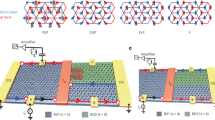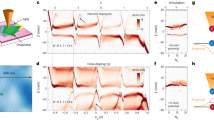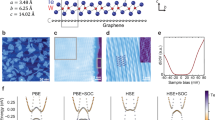Abstract
Undoped graphene is a gapless semiconductor; however, when placed under a high perpendicular magnetic field and cooled to low temperature, it develops an insulating state. This state, dubbed ν = 0, is due to the interplay between electronic interactions and the four-fold spin and valley degeneracies in the flat band formed by the n = 0 Landau level. The nature of the ground state of ν = 0, including its spin and valley polarization, is still under debate. Here we observe vanishing bulk thermal transport in monolayer at ν = 0, in contradiction with the expected ground state, which is predicted to have finite thermal conductance even at very low temperature. Our results highlight the need for further investigations on the nature of ν = 0.
This is a preview of subscription content, access via your institution
Access options
Access Nature and 54 other Nature Portfolio journals
Get Nature+, our best-value online-access subscription
$32.99 / 30 days
cancel any time
Subscribe to this journal
Receive 12 print issues and online access
$259.00 per year
only $21.58 per issue
Buy this article
- Purchase on SpringerLink
- Instant access to full article PDF
Prices may be subject to local taxes which are calculated during checkout





Similar content being viewed by others
Data availability
The data shown here are available on Zenodo at https://doi.org/10.5281/zenodo.10528559 (ref. 45). Source data are provided with this paper.
Code availability
The analysis codes are available on Zenodo at https://doi.org/10.5281/zenodo.10528559 (ref. 45).
References
Kharitonov, M. Phase diagram for the ν = 0 quantum Hall state in monolayer graphene. Phys. Rev. B 85, 155439 (2012).
Nomura, K. & MacDonald, A. H. Quantum Hall ferromagnetism in graphene. Phys. Rev. Lett. 96, 256602 (2006).
Alicea, J. & Fisher, M. P. A. Graphene integer quantum Hall effect in the ferromagnetic and paramagnetic regimes. Phys. Rev. B 74, 075422 (2006).
Fertig, H. A. & Brey, L. Luttinger liquid at the edge of undoped graphene in a strong magnetic field. Phys. Rev. Lett. 97, 116805 (2006).
Jung, J. & MacDonald, A. H. Theory of the magnetic-field-induced insulator in neutral graphene sheets. Phys. Rev. B 80, 235417 (2009).
Goerbig, M. O. Electronic properties of graphene in a strong magnetic field. Rev. Mod. Phys. 83, 1193–1243 (2011).
Wu, F., Sodemann, I., Araki, Y., MacDonald, A. H. & Jolicoeur, T. SO(5) symmetry in the quantum Hall effect in graphene. Phys. Rev. B 90, 235432 (2014).
de Nova, J. R. M. & Zapata, I. Symmetry characterization of the collective modes of the phase diagram of the ν = 0 quantum Hall state in graphene: mean-field phase diagram and spontaneously broken symmetries. Phys. Rev. B 95, 165427 (2017).
Knothe, A. & Jolicoeur, T. Edge structure of graphene monolayers in the 𝜈 = 0 quantum Hall state. Phys. Rev. B 92, 165110 (2015).
Atteia, J. & Goerbig, M. O. SU(4) spin waves in the ν = ±1 quantum Hall ferromagnet in graphene. Phys. Rev. B 103, 195413 (2021).
Das, A., Kaul, R. K. & Murthy, G. Coexistence of canted antiferromagnetism and bond order in ν = 0 graphene. Phys. Rev. Lett. 128, 106803 (2022).
Hegde, S. S. & Villadiego, I. S. Theory of competing charge density wave, Kekulé, and antiferromagnetically ordered fractional quantum Hall states in graphene aligned with boron nitride. Phys. Rev. B 105, 195417 (2022).
De, S. J., Das, A., Rao, S., Kaul, R. K. & Murthy, G. Global phase diagram of charge-neutral graphene in the quantum Hall regime for generic interactions. Phys. Rev. B 107, 125422 (2023).
Abanin, D. A. et al. Dissipative quantum Hall effect in graphene near the Dirac point. Phys. Rev. Lett. 98, 196806 (2007).
Checkelsky, J. G., Li, L. & Ong, N. P. Zero-energy state in graphene in a high magnetic field. Phys. Rev. Lett. 100, 206801 (2008).
Amet, F., Williams, J. R., Watanabe, K., Taniguchi, T. & Goldhaber-Gordon, D. Insulating behavior at the neutrality point in single-layer graphene. Phys. Rev. Lett. 110, 216601 (2013).
Young, A. F. et al. Tunable symmetry breaking and helical edge transport in a graphene quantum spin Hall state. Nature 505, 528–532 (2014).
Zibrov, A. A. et al. Even-denominator fractional quantum Hall states at an isospin transition in monolayer graphene. Nat. Phys. 14, 930–935 (2018).
Stepanov, P. et al. Long-distance spin transport through a graphene quantum Hall antiferromagnet. Nat. Phys. 14, 907–911 (2018).
Veyrat, L. et al. Helical quantum Hall phase in graphene on SrTiO3. Science 367, 781–786 (2020).
Fu, H., Huang, K., Watanabe, K., Taniguchi, T. & Zhu, J. Gapless spin wave transport through a quantum canted antiferromagnet. Phys. Rev. X 11, 021012 (2021).
Liu, X. et al. Visualizing broken symmetry and topological defects in a quantum Hall ferromagnet. Science 375, 321–326 (2022).
Coissard, A. et al. Imaging tunable quantum Hall broken-symmetry orders in graphene. Nature 605, 51–56 (2022).
Takei, S., Yacoby, A., Halperin, B. I. & Tserkovnyak, Y. Spin superfluidity in the ν = 0 quantum Hall state of graphene. Phys. Rev. Lett. 116, 216801 (2016).
Pientka, F., Waissman, J., Kim, P. & Halperin, B. I. Thermal transport signatures of broken-symmetry phases in graphene. Phys. Rev. Lett. 119, 027601 (2017).
Wei, N., Huang, C. & MacDonald, A. H. Scattering of magnons at graphene quantum-Hall-magnet junctions. Phys. Rev. Lett. 126, 117203 (2021).
Jezouin, S. et al. Quantum limit of heat flow across a single electronic channel. Science 342, 601–4 (2013).
Srivastav, S. K. et al. Universal quantized thermal conductance in graphene. Sci. Adv. 5, eaaw5798 (2019).
Srivastav, S. K. et al. Vanishing thermal equilibration for hole-conjugate fractional quantum Hall states in graphene. Phys. Rev. Lett. 126, 216803 (2021).
Srivastav, S. K. et al. Determination of topological edge quantum numbers of fractional quantum Hall phases by thermal conductance measurements. Nat. Commun. 13, 5185 (2022).
Le Breton, G. et al. Heat equilibration of integer and fractional quantum Hall edge modes in graphene. Phys. Rev. Lett. 129, 116803 (2022).
Melcer, R. A., Konyzheva, S., Heiblum, M. & Umansky, V. Direct determination of the topological thermal conductance via local power measurement. Nat. Phys. 19, 327–332 (2023).
Pendry, J. B. Quantum limits to the flow of information and entropy. J. Phys. A 16, 2161–2171 (1983).
Rego, L. G. C. & Kirczenow, G. Fractional exclusion statistics and the universal quantum of thermal conductance: a unifying approach. Phys. Rev. B 59, 13080–13086 (1999).
Schwab, K., Henriksen, E. A., Worlock, J. M. & Roukes, M. L. Measurement of the quantum of thermal conductance. Nature 404, 974–977 (2000).
Meschke, M., Guichard, W. & Pekola, J. P. Single-mode heat conduction by photons. Nature 444, 187–190 (2006).
Banerjee, M. et al. Observed quantization of anyonic heat flow. Nature 545, 75–79 (2017).
Melcer, R. A. et al. Heat conductance of the quantum Hall bulk. Nature 625, 489–493 (2024).
Wei, D. S. et al. Electrical generation and detection of spin waves in a quantum Hall ferromagnet. Science 362, 229–233 (2018).
Kharitonov, M. Canted antiferromagnetic phase of the ν = 0 quantum Hall state in bilayer graphene. Phys. Rev. Lett. 109, 046803 (2012).
Peterson, M. R. & Nayak, C. Effects of Landau level mixing on the fractional quantum Hall effect in monolayer graphene. Phys. Rev. Lett. 113, 086401 (2014).
Khanna, U. et al. Phase diagram of the ν = 2 quantum Hall state in bilayer graphene. Phys. Rev. B 108, L041107 (2023).
Kumar, R. et al. Absence of heat flow in ν = 0 quantum Hall ferromagnet in bilayer graphene. Nat. Phys. https://doi.org/10.1038/s41567-024-02673-z (2024).
Assouline, A. et al. Excitonic nature of magnons in a quantum Hall ferromagnet. Nat. Phys. 17, 1369–1374 (2021).
Parmentier, F. Data and analysis files for “Vanishing bulk heat flow in the ν=0 quantum Hall ferromagnet in monolayer graphene”. Zenodo https://doi.org/10.5281/zenodo.10528559 (2024).
Acknowledgements
This work was funded by the ERC (ERC-2018-STG QUAHQ), by the Investissements d’Avenir LabEx PALM (ANR-10-LABX-0039-PALM) and by the Region Ile de France through the DIM QUANTIP. K.W. and T.T. acknowledge support from the JSPS KAKENHI (grant numbers 21H05233 and 23H02052) and World Premier International Research Center Initiative (WPI), MEXT, Japan. O.M. acknowledges funding from the ANR (ANR-23-CE47-0002 CRAQUANT). We thank A. Das, R. Kumar, S. K. Srivastav, M. Goerbig, T. Jolicoeur, C. Altimiras, R. Ribeiro-Palau, Y. Hong and P. Jacques for enlightening discussions as well as technical advice and support.
Author information
Authors and Affiliations
Contributions
F.D.P. conceived and designed the experiments. R.D., M.G. and F.D.P. fabricated the devices, with inputs from G.L.B. and A.Z. R.D., M.G., G.L.B., A.Z., O.M. and F.D.P. performed the experiments, analysed the data and discussed the results, with inputs from P. Roche. T.T. and K.W. synthesized the bulk hBN crystals. Q.D. and Y.J. provided the low-noise cryogenic preamplifiers used in the noise measurements. R.D., M.G., P. Roulleau, O.M., P. Roche and F.D.P. wrote the paper, with inputs from all co-authors.
Corresponding author
Ethics declarations
Competing interests
The authors declare no competing interests.
Peer review
Peer review information
Nature Physics thanks Ganpathy Murthy, Haoxin Zhou and the other, anonymous, reviewer(s) for their contribution to the peer review of this work.
Additional information
Publisher’s note Springer Nature remains neutral with regard to jurisdictional claims in published maps and institutional affiliations.
Supplementary information
Supplementary Information
Supplementary Figs. 1–25 and Discussion.
Source data
Source Data Fig. 2
Statistical source data.
Source Data Fig. 3
Statistical source data.
Source Data Fig. 4
Statistical source data.
Source Data Fig. 5
Statistical source data.
Rights and permissions
Springer Nature or its licensor (e.g. a society or other partner) holds exclusive rights to this article under a publishing agreement with the author(s) or other rightsholder(s); author self-archiving of the accepted manuscript version of this article is solely governed by the terms of such publishing agreement and applicable law.
About this article
Cite this article
Delagrange, R., Garg, M., Le Breton, G. et al. Vanishing bulk heat flow in the ν = 0 quantum Hall ferromagnet in monolayer graphene. Nat. Phys. 20, 1927–1932 (2024). https://doi.org/10.1038/s41567-024-02672-0
Received:
Accepted:
Published:
Issue date:
DOI: https://doi.org/10.1038/s41567-024-02672-0
This article is cited by
-
No heat flow in charge-neutral graphene
Nature Physics (2024)
-
Absence of heat flow in ν = 0 quantum Hall ferromagnet in bilayer graphene
Nature Physics (2024)



